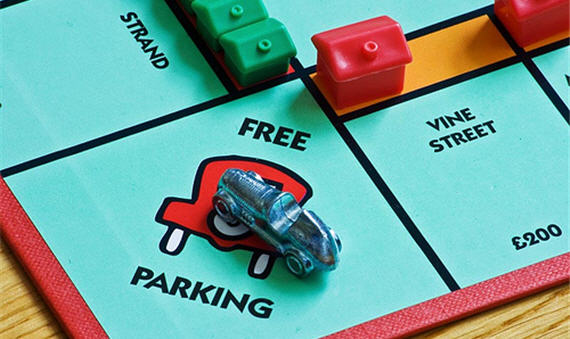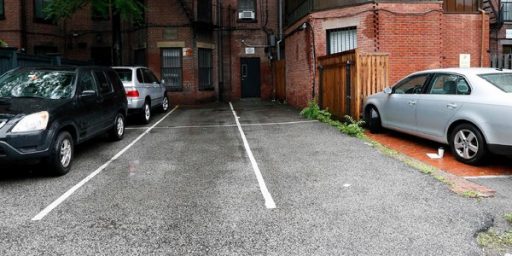Parking Space Economics
Free parking is a very inefficient use of land resources that wouldn't exist without government mandates and subsidies. Is it time to end the practice?
Tyler Cowen has set off quite a firestorm with a NYT column arguing that government mandates for free or very inexpensive parking are “a classic tale of how subsidies, use restrictions, and price controls can steer an economy in wrong directions.”
Many suburbanites take free parking for granted, whether it’s in the lot of a big-box store or at home in the driveway. Yet the presence of so many parking spaces is an artifact of regulation and serves as a powerful subsidy to cars and car trips. Legally mandated parking lowers the market price of parking spaces, often to zero. Zoning and development restrictions often require a large number of parking spaces attached to a store or a smaller number of spaces attached to a house or apartment block.
If developers were allowed to face directly the high land costs of providing so much parking, the number of spaces would be a result of a careful economic calculation rather than a matter of satisfying a legal requirement. Parking would be scarcer, and more likely to have a price — or a higher one than it does now — and people would be more careful about when and where they drove.
The subsidies are largely invisible to drivers who park their cars — and thus free or cheap parking spaces feel like natural outcomes of the market, or perhaps even an entitlement. Yet the law is allocating this land rather than letting market prices adjudicate whether we need more parking, and whether that parking should be free. We end up overusing land for cars — and overusing cars too. You don’t have to hate sprawl, or automobiles, to want to stop subsidizing that way of life.
Tim Lee chimes in, saying Cowen doesn’t even consider other negative consequences.
A key point to emphasize here is that parking mandates aren’t just a subsidy to car ownership, they’re also a burden on pedestrians, who must trek across parking lots to get to almost any building. So not only does walking mean giving up the state-mandated subsidy of free parking, but it also means walking significantly further than you’d have to in a city where the availability of parking was determined by market forces.
And this results in the opposite of the virtuous cycle I wrote about a few weeks ago: as density falls, you get fewer pedestrians, which depletes the market for small, pedestrian-friendly establishments. And fewer pedestrian-friendly businesses establishments means that even fewer people walk. The result is the situation in most cities in the Midwest and the Sun Belt, where even people who strongly prefer to live in a “walkable” neighborhood find there are few if any neighborhoods that cater to that preference.
There’s no question that we subsidize parking and thus incentivize driving. But, given that we’ve been doing it for more than half a century and have quite literally built a country around personalized transportation, it’s hardly clear that changing the regulations would fix the problems. And the pain of the transition would be enormous.
Over at his blog, Cowen admits that it’s not cut-and-dried:
First, the danger of spillover parking means that a lot of parking has to be properly priced all at once. If the local K-Mart has a smaller lot, you don’t want the customers flooding a neighborhood street and simply shifting the problem. The proper correction requires a coordinated pricing and enforcement effort, not only to succeed, but also to be sufficiently popular with homeowners. Fortunately, most of the coordination can be done at the level of the individual town or city.
Second, we don’t yet know how many more spaces would be priced in the absence of legal minimum parking requirements, and how many fewer car trips there would be, especially if we are holding the quantity and quality of mass transit constant. The employer still may wish to subsidize appearance at the workplace. Alternatively, “parking fees as lump sum tax” is fine by me and it bears an odd but pleasant connection to Georgist ideas. Another possibility is that a lot of parking is shifted to satellite lots, combined with small buses or shuttles; Tysons Corner Mall already does this at Christmas or consider any number of airports. That still would improve land use (and welfare), but it remains an open question how much congestion and emissions would get better.
Arnold Kling argues that “there is a lot of confusion between fixed costs and marginal costs.”
Creating a parking place carries fixed costs. However, the marginal cost of using a parking space is often zero.
The marginal cost of using a cell phone network is often zero, so your cell phone company tries to offer you a plan that makes the marginal cost feel like zero to you. It could be that free parking emerges for the same reason.
If we abolished free parking, would parking spaces be scarcer? Keep in mind that if the price of parking went up, this would cause movement along the supply curve as well as along the demand curve. Maybe the total number of parking places would decline (it depends on elasticities), but the one result you can predict with certainty is that the number of unused parking places would go up. Is that necessarily welfare-improving?
Mark Thoma worries about the distributionist consequences of high-priced parking.
As the price of a good or service rises, it begins to price some people out of the market. I don’t mean that they choose to consume other things instead, I mean that no matter how much they want it, they can never have it. It’s not a matter of desire, or willingness to pay, they simply cannot raise the needed funds — it’s just not possible to afford the good or service in question.
Because of this there are some goods and services controlled by government, national parks come to mind, where we choose to allocate goods by other means than the price system, lotteries, waiting time, random draws, that sort of thing. It generally occurs when we think equity is a primary consideration, i.e. that everyone should have a relatively equal shot at consuming a good or service.
[…]
As we begin to price public areas with market based mechanisms — places owned by all of us — we need to think hard about equity and make sure we don’t exclude certain segments of the population from access to these goods, services, and places. Sometimes market based allocations are fine, but not always.
Then again, Cowen notes, “less land for parking should lower other real estate and retail prices, even if more poor people end up taking the bus. And the very poorest Americans often don’t have cars at all.”
Robin Hanson, meanwhile, can’t understand why economists like Thoma and Kling work so hard to refute simple microeconomic analysis.
Why should we treat parking spots much different than thousands of other familiar products whose average costs are often above marginal costs? Should we require every mall to have enough movie theaters seats to handle the premier of a record blockbuster, all because since theatres are rarely full their marginal cost is near zero? How about similarly requiring a vast supply of restaurant tables which would then rarely be full?
Sometimes good economic analysis says that the world should be different than it is. Yes you should wonder if such an analysis is missing something important. But you shouldn’t strain too much just to justify the status quo. We require the creation of way too much parking, and we’d be better off to coordinate to stop it.
To all this, I’d add a couple of points.
First, this is a very difficult conversation to have because of the radical differences in reference frames of the two sides. Aside from economists, anti-free parking types are invariably urban dwellers where parking is difficult and the demand for every square foot of space is high. People who live in suburbs, especially those that don’t regularly drive into the handful of dense urban centers where any of this matters, are befuddled. Nobody would pay to park at the Hamilton Place mall on the outskirts of Chattanooga. At the Pentagon City mall, nobody thinks twice.
Second, while ordinances requiring the allocation of parking spots for apartment buildings, storefronts, and the like are doubtless a boon to car owners, they are mostly an attempt to limit negative externalities. If I build an apartment complex in a major downtown center and provide no parking, I’m obviously less competitive than those who do. But, at the same time, those who live in my building who own cars are going to have to park somewhere, and they’ll therefore occupy spaces — often for hours and days on end — that could otherwise be used by short-term parkers who want to patronize the local merchants, taverns, and restaurants. Similarly, if I run a downtown business that caters to clients who don’t need to come to my storefront, I’d never pay to construct parking spaces for my employees, as it’d be cheaper to subsidize their parking elsewhere. But, again, that means my employees, who arrive before the shops open, are taking up spots that could be used by customers of service-oriented businesses.
Taking both of these into consideration, then, it seems to me that the key good to control is street parking in crowded downtown areas at peak hours. We want residents of apartment buildings and houses and employees of businesses to be out of the way to accommodate short-term parking that allows commerce to take place. So, in places where street parking is scarce, charge variable rates at meters and limit the number of hours that can be parked there. (A tangentially related pet peeve: And delivery vehicles can’t be allowed to take up these spaces, much less double park, which means that those activities have to be time-shifted to the early morning or late evening hours.)
These regulations would be anathema in most of the United States, which simply isn’t crowded enough to have that kind of government intervention in the lives of citizens. But it makes sense in New York, Boston, DC, San Francisco, and a handful of other metro areas long since accustomed to the need for state to smooth over daily interactions.







I accept that we should abandon free parking requirements in zoning. But then I still put a non-zero probability on $5/gal gas, and 10 sea level rise.
A related issue, probably off-limits, is why we have (allow) minimum lot size and building size zoning. We’d be more “efficient” if anyone with a ranch house on a 1/4 acre lot could split it and build two townhouses.
True. But that imposes externalities on the neighbors: More traffic, noise, wear-and-tear, blight, lowered property values, etc.
There seems to be this odd assumption that pricing parking or limiting it would result in people abandoning their cars. More likely, they’ll just keep on driving to the place down the road with ample free parking. Megan McCardle just touched on this in her post on grocery shopping in DC. Users of public transportation tend to buy less and go to the shop more often. This low item count/high body count requires more labor to achieve the same sales. Not to mention, usually single or no children so you have the extra time for the extra shopping.
And they also seem to always discount children, except as pawns attending the local indoctrination center. Ever tried to carry a child, a stroller, a diaper bag, etc. all by yourself on public transportation? Even foregoing the ticket charge, trying to control and keep safe a toddler in the uncontrolled mass transit environment is a lot more tiring than strapping them into a seat in the driveway and parking lot. How long before some well meaning busybody decides that children on buses need to be in child restraint devices?
Fact is, beyond the few urban areas mention, to go somewhere requires a car for part of the trip so except for forced interactions with the state, i.e., going to court, it is easier to just stay in the car and continue on to car friendly location for shopping or recreation. Start charging or limiting parking and see how fast a mall with free parking goes up just down the freeway outside the busybody’s reach.
Many of these arguments seem to apply to non-toll roads as well. A few of them even apply to sidewalks which are free to walk on. And nobody’s interested in stopping every half-block to drop a nickel in the sidewalk toll. So I would agree with Joyner that there’s probably a decent balance to be had in just controlling peak hours, although I would assume city planners have tried to think of reasonable ways to implement that.
Also, some fraction of the problem is the size of vehicles that need to be supported. Roughly half of Americans are riding around solo in 6000-lb SUVs capable of cruising at 90 mph all day long, when a Smart car at less than half the size and weight would do just fine for 98% of their trips. Half the size, half the parking area, period.
I’ve been watching this debate myself for a few days and I think James touched on what I believe to be the biggest salient point, but didn’t emphasize it enough. In my mind, this is one of the biggest issues where many Americans are going to talk past each for the simple reason that the optimal policy is vastly different in different areas of the country.
As James himself mentioned, in a lot of suburban areas the zoning rules have little or nothing to do with ensuring that free parking exists. Where I live, it WILL exist – land is simply too cheap here. The question is who will provide it, and if a given establishment doesn’t provide it, then that establishment’s customers/employees/renters/whatever will be, in effect, “stealing” free parking from some other establishment’s customers/employees/renters/whatever. The regulations are basically just saying that you have to provide your own free parking instead of using your neighbors. But SOMEBODY will provide it, ultimately, because it just makes better business sense around here. If you don’t have parking available, people simply won’t shop at your store. In this part of the country, they won’t even consider it.
In major urban areas, of course, the economics are completely different. Land is much more expensive and the opportunity cost lost by using a given space for parking is not trivial. Also, public transportation et al is simply much more practical already, given the population density, and because of that public transit tends to already exist on a more practical scale, thus making it much easier to travel to any given establishment that doesn’t offer parking.
The economics are just totally different. In urban areas it’s clear that free parking is often an inefficient use of the land. In rural areas, I think it actually IS an efficient use of the land, at least some of the time. Even when it’s not, it’s much less clear that it’s not. So the optimum situation would be for a federal style system where the locals set the rules based on what makes the most sense in the area.
Oh wait, that’s what we already have.
Some of Cowen’s premises don’t ring true. In my experience, major developments are built around landing a major retailer, and developers compete with each other to land that retailer. They don’t compete by pointing out that parking will be scarce, particularly during the Holiday season. Major retailers do have economic calculations showing their parking needs.
And developers hate zoning requirements for “green space” in the parking lots.
Less free parking places also places negative externalities on neighbors.
(It all comes down to “how libertarian are you, really?” I think I might be libertarian enough to drastically reduce the role of zoning, and rely on “neighborhood associations” to take up the slack. In other words, if you want a fixed landscape, buy in to a corporate entity with frontages in common. Abolishing minimum size restrictions would just heighten (return?) the distinction between planned and unplanned communities.)
At the former Fitzsimmons Army Medical Center (now the Fitzsimmons Medical Campus) they have implemented paid parking. Sometimes I’m tempted to go over there to get a sandwich at Jimmy Johns. But every time I do, I can’t find a parking spot, don’t have enough change, end up circling in frustration, etc.
So I just go across the street and eat at the Spicy Pickle where they have free parking.
Instead of demanding parking space owners start charging….I think we should re-aquaint ourselves with the horse. Horses crap fertilizer, don’t burn fossil fuels, don’t require expensive mining of rare metals and fabricating plastics. They cost less than a car, and if you hook them up to a cart, you can even take it to Wal-Mart!
(And yes, I’m half-joking…but wouldn’t this take care of the problems the anti-free parking crowd is trying to fix?)
“There’s no question that we subsidize parking and thus incentivize driving. But, given that we’ve been doing it for more than half a century and have quite literally built a country around personalized transportation, it’s hardly clear that changing the regulations would fix the problems.”
The most startling example of this is Los Angeles. I was talking to someone the other day who’d just been to LA, and was bitching about the traffic. When I told him that Los Angeles at one time had the most advanced public transportation system in the United States, he was incredulous. And you might be, too. However, take a look at
Pacific Electric Railway [http://en.wikipedia.org/wiki/Pacific_Electric_Railway]
The Pacific Electric Railway … also known as the Red Car system, was a mass transit system in Southern California using streetcars, light rail, and buses. At its greatest extent, around 1925, the system interconnected cities in Los Angeles and Orange Counties and also connected to Riverside County and San Bernardino County in the Inland Empire.
The system was divided into three districts:
Northern District: Pasadena, San Gabriel Valley including Alhambra, El Monte, Glendora, Monrovia, Pomona, San Bernardino.
Southern District: Long Beach, Newport Beach, Huntington Beach, San Pedro via Dominguez, Santa Ana, El Segundo, Redondo Beach via Gardena, San Pedro Via Torrance.
Western District: Hollywood, Burbank/Glendale, San Fernando Valley, Beverly Hills, Santa Monica, Manhattan/Redondo/Hermosa Beaches, Venice, Playa Del Rey.
See especially this, a map of the system:
http://en.wikipedia.org/wiki/File:Relief_map_Pacific_Electric_Railway.jpg
It was still a going concern in 1958, when I was stationed for a time at the old Long Beach naval base. I could grab a red car to downtown LA, then grab an electric trolley to my home in West LA (had to walk a few blocks after getting off).
Of course, it’s all gone now. Just a memory to old guys like me. Who did kill Roger Rabbit?
“And they also seem to always discount children, except as pawns attending the local indoctrination center.”
Wow…some people really HATE public education…oh well, there’s always home schooling for such people to utilize… 🙂
I’m pretty sure that current DC zoning law requires that all new commercial construction provide adequate parking (not necessarily free) to meet the needs of the intended structure.
Just LOOK what mandating indoor plumbing has done to the pay toilet industry!
And the cost for infrastructure!?!? GEEESH!
If developers were allowed to face directly the high land costs of providing so much plumbing, the number of toilets would be a result of a careful economic calculation rather than a matter of satisfying a legal requirement. Plumbing would be scarcer, and more likely to have a price — or a higher one than it does now — and people would be more careful about when and where they go.
The idea that parking spaces are free does not comport with reality. Mall owners first pay for the land that includes the parking lot, second, they pay property taxes on the mall and the surrounding parking lots. This cost is passed on to the store owners/lessors and that cost is passed on to the shoppers in those stores through the pricing mechanism. There is no such thing as “free” parking.
What is this “free parking” of which they’re writing? I know of no such thing here in Chicago. This strikes me as something like Bigfoot or Nessie, something of which stories are told but not found in nature. “Ah, me chicks. When I was a girl there was free parking.”
Sarasota, FL still has mostly-free parking… city-owned lots are free, as is on-street parking (with time limits). Even the hospital has free parking. There are a few, privately-owned lots in very desirable areas that charge for parking, but that’s about it.
The city is considering installing meters on one or two streets in the middle of downtown, though.
Terry makes the big point. It’s not free, it’s costs are just passed along in a different manner. When parking used to cost money in my town merchants attracted shoppers with free parking. Developers face those costs when they build and in may cases wish they could provide fewer parking spaces but local land use regulations often tell them how many spaces they must provide.
It’s funny too that people speak of wanting “walkable” neighborhoods but they then drive through them. It’s the looks they like not the ability to actually walk.
A community needs the infrastructure for walkability and a critical mass of “normal people” walking out there. People are herd creatures.
Oh, I think people like the ability to walk to the convenience store, restaurants, entertainment, and the like. But, most places that’s possible, it’s either prohibitively expensive for even upper middle class people to live there or comes with high crime and other safety hazards.
Parking is a cost of going to work if one works in a high-density place. Employers must either reimburse or subsidize employee parking if it isn’t free or else pay higher wages or salaries to workers. Such is the free market at work. As I recall in Dallas, center-city employers paid more than suburban employers due to commuting costs in time or money. Downtown Dallas has no free parking, but suburban Dallas has (or had).
Small towns have often found that when they put parking meters up, patronage of downtown stores falls off. I don’t know why people are so loath to put a quarter into a parking meter… but when stores lose shoppers, parking meters vanish. Sure it would be more rational to remove street parking altogether and add a median turn lane that would make traffic flow faster — but traffic would also flow more quickly out of town and with that traffic the opportunity to sell an impulse purchase.
Free parking? It depends upon whether one is a merchant who doesn’t have a steady stream of captive customers or whether one has an office building.